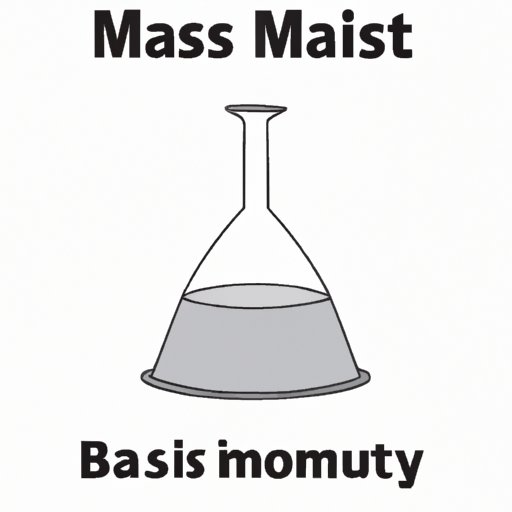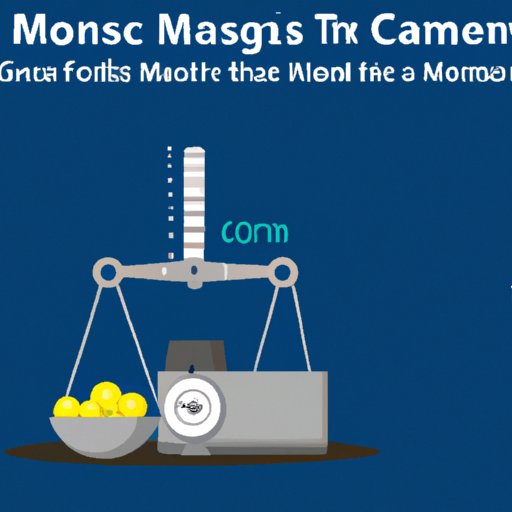
Introduction
Calculating mass to weight may seem like a daunting task, but it is a fundamental part of many fields ranging from physics to engineering. Understanding the difference between mass and weight is critical to performing accurate calculations. This article will provide a beginner-friendly guide to calculating mass to weight. We will explore the difference between mass and weight, step-by-step guidance on calculating mass to weight, the importance of calculating it accurately, and tricks and techniques to avoid common mistakes. In addition, this article will explore the science behind mass to weight conversion and expert advice for perfecting mass to weight conversion.
Understanding the Difference between Mass and Weight and How to Calculate Them
Before delving into the calculation of mass and weight, it is necessary to understand the definitions of these two terms.
Mass refers to the amount of matter that an object contains. It is an intrinsic property and remains constant regardless of an object’s location. The standard unit of measure for mass is kilograms (kg).
Weight, on the other hand, refers to the amount of force that gravity exerts on an object. It is a measure of the gravitational force acting on an object. Weight varies with changes in gravity and, therefore, changes depending on the object’s location. The standard unit of measure for weight is newtons (N).
The formula to calculate mass is: m = F/a, where m is the mass, F is the force, and a is the acceleration. The formula to calculate weight is: w = mg, where w is the weight, m is the mass, and g is the acceleration due to gravity.
5 Simple Steps to Calculate Mass to Weight: A Beginner’s Guide
Now that we understand the difference between mass and weight, let’s dive into a simple guide on how to calculate mass to weight.
Step 1: Determine the mass of the object
The first step in calculating mass to weight is determining the object’s mass in kilograms. Use a digital scale to measure the object’s weight in kg directly.
Step 2: Determine the gravity acceleration constant
The standard gravity acceleration constant is 9.81 m/s². This constant is used to calculate an object’s weight when on the surface of the earth.
Step 3: Multiply the mass by the acceleration due to gravity
Multiply the object’s mass in kilograms by the acceleration due to gravity in m/s² (9.81 m/s²). The answer will be the object’s weight in Newtons (N).
Step 4: Confirm the answer unit
Always double-check the unit of the answer. Remember that the weight is measured in Newtons (N).
Step 5: Record your answer
Write down the weight of the object, in Newtons (N).
Why Calculating Mass to Weight is Important: Tips and Tricks
The importance of calculating mass to weight accurately cannot be overemphasized. It is essential in various fields like physics, engineering, and chemistry. Incorrect mass or weight values can lead to wrong calculations and decisions, resulting in damage or even danger. Here are some tips for making sure that your calculations are precise:
- Use the correct formula for calculating mass to weight.
- Be precise when measuring the mass of the object.
- Always use the standard acceleration due to gravity when doing calculations.
Here are some additional tricks for simplifying the process:
- Round off numbers to avoid errors. But, remember, rounding off too much can lead to incorrect results.
- Use online calculators to quickly determine values, ensuring that you always have accurate results.
Mastering the Art of Converting Mass to Weight: A Comprehensive Guide
Converting mass to weight involves using formulas that allow us to determine the weight of an object by multiplying its mass by the acceleration due to gravity at that location.
Step 1: Determine the mass of the object in kilograms
The first step in converting mass to weight is determining the mass of the object in kilograms.
Step 2: Determine the gravity acceleration constant
The acceleration due to gravity varies depending on the location of the object. Use the Table of Gravitational Acceleration by Country to determine the gravity acceleration constant for your location.
Step 3: Multiply the mass by the acceleration due to gravity
Multiply the object’s mass in kilograms by the acceleration due to gravity in m/s². The answer will be the object’s weight in Newtons.

Avoiding Common Mistakes in Calculating Mass to Weight: Top Tricks and Techniques
Performing accurate mass to weight calculations requires attention to detail and precision. Here are some common errors to avoid when calculating mass to weight:
- Confusing mass with weight and vice versa
- Using the wrong formula or formula variables (e.g., acceleration instead of acceleration due to gravity)
- Incorrectly rounding off numbers
- Forgetting to include units when recording the answer
Here are some techniques for avoiding these mistakes:
- Double-check the formula and formula variables to ensure that you are using the correct one.
- Pay attention to the values of each variable to ensure that you include the correct unit in your answer.
- Check your work for errors and ensure that you have used the correct formula and variables.
Exploring the Science behind Mass to Weight Conversion: The Ultimate Tutorial
To understand the science behind mass to weight conversion, we must first understand the law of gravitation. The law states that any two objects attract each other with a force proportional to their masses and inversely proportional to the square of the distance between them. The force is also proportional to the acceleration due to gravity.
The formula for calculating mass to weight uses the mass of an object, the acceleration due to gravity at that location, and the law of gravitation. By understanding these concepts, we can accurately calculate an object’s weight regardless of its location.
Cracking the Mass to Weight Conversion Code: Expert Advice
Expert advice for perfecting mass to weight conversion is mainly about ensuring that you are methodical and precise in your approach. Here are some tips:
- Double-check each step of the calculation to ensure that you have not made any errors.
- Always use the correct formula and formula variables.
- Use an online calculator to quickly and easily check your work, ensuring that your calculations are accurate.
Conclusion
We have discussed the difference between mass and weight, the importance of accurately calculating mass to weight, and provided a detailed guide on how to calculate mass to weight. We also explored techniques for avoiding and correcting common errors, and a comprehensive guide to converting mass to weight. Using these tips and techniques, anyone can master the art of calculating mass to weight accurately and with ease.




